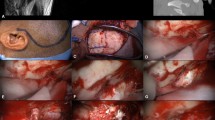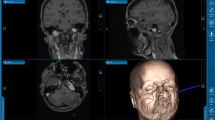Abstract
Introduction
The facial nerve follows a complex course through the skull base. Understanding its anatomy is crucial during standard skull base approaches and resection of certain skull base tumors closely related to the nerve, especially, tumors at the cerebellopontine angle.
Methods
Herein, we review the fallopian canal and its implications in surgical approaches to the skull base. Furthermore, we suggest a new classification.
Conclusions
Based on the anatomy and literature, we propose that the meatal segment of the facial nerve be included as a component of the fallopian canal. A comprehensive knowledge of the course of the facial nerve is important to those who treat patients with pathology of or near this cranial nerve.




Similar content being viewed by others
References
Phillips CD, Bubash LA (2002) The facial nerve: anatomy and common pathology. Seminars in Ultrasound, CT, and MR 23:202–217
Wilson-Pauwels L, Akesson E, Stewart P (1988) Cranial nerves, anatomy and clinical comments. B.C. Decker, Philadelphia
Salib RJ, Tziambazis E, McDermott AL, Chavda SV, Irving RM (2001) The crucial role of imaging in detection of facial nerve haemangiomas. J Laryngol Otol 115:510–513
Yurtseven T, Savas R, Kocak A, Turhan T, Aktas EO, Islekel S (2004) Relationship between anterior inferior cerebellar artery and facial-vestibulocochlear nerve complex: an anatomical and magnetic resonance images correlation study. Minim Invasive Neurosurg 47:306–311
Kim HS, Kim DI, Chung IH, Lee WS, Kim KY (1998) Topographical relationship of the facial and vestibulocochlear nerves in the subarachnoid space and internal auditory canal. Am J Neuroradiol 19:1155–1161
Rubinstein D, Sandberg EJ, Cajade-Law AG (1996) Anatomy of the facial and vestibulocochlear nerves in the internal auditory canal. Am J Neuroradiol 17:1099–1105
Tian GY, Xu DC, Huang DL, Liao H, Huang MX (2008) The topographical relationships and anastomosis of the nerves in the human internal auditory canal. Surg Radiol Anat 30:243–247
Leblanc A (1992) Anatomy and imaging of the cranial nerves: a neuroanatomic method of investigation using magnetic resonance imaging (MRI and computed tomography). Springer, Heidelberg
Amjad AH, Scheer AA, Rosenthal J (1969) Human internal auditory canal. Arch Otolaryngol 89:709–714
Gonzalez F, Ferreira M, Zabramski J, Spetzler R, Deshmukh P (2000) The middle fossa approach. Barrow Quarterly 16
Sanna M, Saleh E, Russo A, Falcioni M (2001) Identification of the facial nerve in the translabyrinthine approach: an alternative technique. Otolaryngol Head Neck Surg 124:105–106
Brunsteins DB, Ferreri AJ (1990) Microsurgical anatomy of VII and VIII cranial nerves and related arteries in the cerebellopontine angle. Surg Radiol Anat 12:259–265
Mazzoni A, Hansen CC (1970) Surgical anatomy of the arteries of the internal auditory canal. Arch Otolaryngol 91:128–135
Veillona F, Ramos-Taboada L, Abu-Eid M, Charpiot A, Riehm S (2010) Imaging of the facial nerve. Eur J Radiol 74:341–348
Anson BJ, Donaldson JA, Warpeha RL, Rensink MJ, Shilling BB (1973) Surgical anatomy of the facial nerve. Arch Otolaryngol 97:201–213
Swartz JD (1984) The facial nerve canal: CT analysis of the protruding tympanic segment. Radiology 153:443–447
Maru N, Cheita AC, Mogoanta CA, Prejoianu B (2010) Intratemporal course of the facial nerve: morphological, topographic and morphometric features. Rom J Morphol Embryol 51:243–248
Perry JR, Hasso AN (1996) Magnetic resonance imaging of cranial nerve VII. Top Mag Reson Imag 8:155–163
Nikolaidis V, Nalbadian M, Psifidis A, Themelis C, Kouloulas A (2009) The tympanic segment of the facial nerve: anatomical study. Clin Anat 22:307–310
Yadav S, Ranga A, Sirohiwal B, Chanda R (2006) Surgical anatomy of tympano-mastoid segment of facial nerve. Indian J Otolaryngol 58:27–30
Haynes DR (1955) The relations of the facial nerve in the temporal bone. Ann R Coll Surg Engl 16:175–185
Nitek S, Wysocki J, Niemczyk K, Ungier E (2006) The anatomy of the tympanic sinus. Folia Morphologica 65:195–199
Yetiser S (2012) The dehiscent facial nerve canal. Int J Otolaryngol 2012:679708
Lin JC, Ho KY, Kuo WR, Wang LF, Chai CY, Tsai SM (2004) Incidence of dehiscence of the facial nerve at surgery for middle ear cholesteatoma. Otolaryngol Head Neck Surg 131:452–456
Boemo RL, Navarrete ML, Pumarola F, Domenech JM, Perello E (2007) Morphometric study of the mastoid segment of the facial nerve. Acta Otorrinolaringologica Espanola 58:178–181
Boemo RL, Navarrete ML, Lareo S, Pumarola F, Chamizo J, Perello E (2008) Anatomical relationship between the position of the sigmoid sinus, tympanic membrane and digastric ridge with the mastoid segment of the facial nerve. Eur Arch Oto Rhino Laryngol 265:389–392
Litton WB, Krause CJ, Anson BA, Cohen WN (1969) The relationship of the facial canal to the annular sulcus. Laryngoscope 79:1584–1604
Adad B, Rasgon BM, Ackerson L (1999) Relationship of the facial nerve to the tympanic annulus: a direct anatomic examination. Laryngoscope 109:1189–1192
Kassem F, Ophir D, Bernheim J, Berger G (2010) Morphology of the human tympanic membrane annulus. Otolaryngol Head Neck Surg 142:682–687
Lindeman H (1960) The fallopian canal. An anatomical study of its distal part. Acta Oto-Laryngologica - Supplement 158:204–211
McManus LJ, Dawes PJ, Stringer MD (2011) Clinical anatomy of the chorda tympani: a systematic review. J Laryngol Otol 125:1101–1108
Blunt MJ (1954) The blood supply of the facial nerve. J Anat 88:520–526
Salame K, Ouaknine GE, Arensburg B, Rochkind S (2002) Microsurgical anatomy of the facial nerve trunk. Clin Anat 15:93–99
Perez B, Campos ME, Rivero J, Lopez Campos D, Lopez-Aguado D (1997) Incidence of dehiscences in the fallopian canal. Int J Pediatr Otorhinolaryngol 40:51–60
Baxter A (1971) Dehiscence of the fallopian canal. An anatomical study. J Laryngol Otol 85:587–594
Di Martino E, Sellhaus B, Haensel J, Schlegel JG, Westhofen M, Prescher A (2005) Fallopian canal dehiscences: a survey of clinical and anatomical findings. Eur Arch Oto Rhino Laryngol 262:120–126
Ozbek C, Tuna E, Ciftci O, Yazkan O, Ozdem C (2009) Incidence of fallopian canal dehiscence at surgery for chronic otitis media. Eur Arch Oto Rhino Laryngol 266:357–362
Barnes G, Liang JN, Michaels L, Wright A, Hall S, Gleeson M (2001) Development of the fallopian canal in humans: a morphologic and radiologic study. Otol Neurotol 22:931–937
Yetiser S, Erol U, Birkent H, Durmaz A (2007) Internal auditory canal enlargement (Giant IAC) and defective fundus in a child with congenital neurosensorial hearing loss. Int J Pediatr Otorhinolaryngol Extra 2:95–98
Hawke M, Jahn A (1987) Diseases of the ear: clinical and pathologic aspects. Lea & Febiger, Philadelphia
Jabor MA, Amedee RG, Gianoli GJ (2000) Primary meningioma of the fallopian canal. South Med J 93:717–720
Foyt D, Brackmann DE (2000) Cerebrospinal fluid otorrhea through a congenitally patent fallopian canal. Arch Otolaryngol Head Neck Surg 126:540–542
Panse R (1904) Klinische und pathologische Mitteilungen: IV. Ein Glioms des Akustikus. Arch Ohr Nas Kehlkopfheilk 61:251–255
House WF (1963) Surgery of the petrous portion of the VII nerve. Ann Otol Rhinol Laryngol 72:802–807
Aslan A, Tekdemir I, Elhan A, Tuccar E (1999) Surgical exposure in translabyrinthine approaches—an anatomical study. Auris, Nasus, Larynx 26:237–243
Pulec JL (1969) Total facial nerve exposure. Arch Otolaryngol 89:179–183
House WF, Belal A Jr (1980) Translabyrinthine surgery: anatomy and pathology. Am J Otol 1:189–198
House WF, De la Cruz A, Hitselberger WE (1978) Surgery of the skull base: transcochlear approach to the petrous apex and clivus. Otolaryngology 86:770–779, ORL
House WF, Hitselberger WE (1976) The transcochlear approach to the skull base. Arch Otolaryngol 102:334–342
Angeli SI, De la Cruz A, Hitselberger W (2001) The transcochlear approach revisited. Otol Neurotol 22:690–695
De la Cruz A, Teufert KB (2009) Transcochlear approach to cerebellopontine angle and clivus lesions: indications, results, and complications. Otol Neurotol 30:373–380
Ciric I, Zhao JC, Rosenblatt S, Wiet R, O’Shaughnessy B (2005) Suboccipital retrosigmoid approach for removal of vestibular schwannomas: facial nerve function and hearing preservation. Neurosurgery 56:560–570, discussion 560–570
Author information
Authors and Affiliations
Corresponding author
Rights and permissions
About this article
Cite this article
Mortazavi, M.M., Latif, B., Verma, K. et al. The fallopian canal: a comprehensive review and proposal of a new classification. Childs Nerv Syst 30, 387–395 (2014). https://doi.org/10.1007/s00381-013-2332-0
Received:
Accepted:
Published:
Issue Date:
DOI: https://doi.org/10.1007/s00381-013-2332-0




